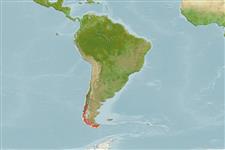Erikus dahli Lowry & Stoddart, 1987
Flash| Native range | All suitable habitat | Point map | Year 2050 |

|
| This map was computer-generated and has not yet been reviewed. |
| Erikus dahli AquaMaps Data sources: GBIF OBIS |
Изображение на Google |
No photo available for this species.
Классификация / Names народные названия | синонимы | CoL | ITIS | WoRMS
Malacostraca | Amphipoda | Amaryllilidae | Amaryllidinae
Environment: milieu / climate zone / пределы глубины / distribution range экология
; пределы глубины 5 - 70 m (ссылка 74426). Temperate
Distribution страны | регионы FAO | Ecosystems | места находок | интродукции
Southeast Pacific: Probably endemic to Chile.
Length at first maturity / Size / Weight / Возраст
половая зрелость: Lm ? range ? - ? cm
Краткое описание морфология
Life cycle and mating behavior половая зрелость | размножение | нерест | Eggs | Fecundity | Larvae
Основная ссылка
ссылки | координатор | соавторы
Lowry, J.K. 2007 Amaryllididae. Australian Museum, Sydney Australia. (ссылка 74426)
Статус Красного Списка МСОП
(ссылка 130435: Version 2025-1)
Статус СИТЕС (ссылка 108899)
CMS (ссылка 116361)
Угроза для людей
Использование человеком
| FishSource |
инструменты
дополнительная информация
состав пищи
потребление пищи
хищники
ресурсы в Интернет
BHL | BOLD Systems | CISTI | DiscoverLife | FAO(Publication : search) | Fishipedia | GenBank (Геном, Нуклеотид) | GloBI | Gomexsi | Google Books | Google Scholar | Google | PubMed | Tree of Life | Wikipedia (Вперёд, поиск) | Zoological Record


